I’ve been so busy finishing a manuscript and taking care of the rest of the business of life that I hardly noticed summer was upon us. But Saturday, at the market, I saw the real harbingers of the season – red currants. Oh my, I walked right over to Mr.Brière, the man who sells me red currants every year, and bought 10 pounds.

I wasted no time. Saturday is always a social day as friends tend to pop in after they’ve been to the market, and I snagged two to help me take the berries off the stem. We sat in the garden which is as lush and flowery as it’s ever been, and re-made the world as we did the sticky work. I then took the berries inside, rinsed them, and put them in a pan to cook just long enough for them to release their juices.

I then bundled up the berries in my gorgeous linen cheesecloth (made with flax grown right outside of town), and left the berries to drain. You’re not supposed to push on them too hard because common wisdom says their juice won’t be clear and bright, so I push just a little bit. Mostly, I just let them drain.

Once the berries have given up their juice, this goes into a pan with sugar (less than half sugar to weight of berries), over medium high heat. Once the juice and sugar begin to boil, I set the timer for 3 minutes. Red currants are full of pectin – if you cook them longer, the jelly gets thick and rubbery. With this slight cooking, it stays tender.

When the liquid comes to a full boil, a pink foam rises to the top. I skim this off. It’s “impurities” though of what sort, I’m not sure. Still, it interferes with the clear brightness, and we don’t want that.
Meanwhile, I’ve got jars and lids in boiling water. In fine French fashion, I re-use jars, and they seal perfectly.

I fill the jars through a funnel, carefully wipe off the edges, and seal them. It’s a quick, slightly messy process but I love it.

Once the jars are filled, I wash everything and after about thirty minutes the jars start to seal as they cool, sending little “pops” into the air.

I always leave a jar unsealed, for my reward.
RED CURRANT JELLY
8 pounds (4 kg) red currants
7 cups (3 pounds; 1-1/2 kg) sugar
1. Prepare fourteen 8-ounce (250ml) canning jars and lids by sterlizing them in boiling water according to the manufacturer’s instructions. Line a fine mesh sieve with cheesecloth and set it over a large bowl.
2. Place the berries, with the rinse water still clinging to them, in a large, heavy stockpot over medium-high heat. When the berries are hot, stir and press on them gently to release their juices.
3. When the berries have released their juices, pour them into the prepared sieve and let the berries drain. When they’ve cooled just a bit, you can fold the cheesecloth up around them and press on the bundle that you’ve formed, gently, to extract more juice. Don’t press too much or too hard.
4. Rinse the stockpot the berries cooked in, and pour in the juice. Add the sugar and stir, then turn the heat to medium-high. When the mixture comes to a boil and the sugar is melted, set the timer for 3 minutes. Skim any pink impurities that rise to the surface.
5. After 3 minutes, remove the pan from the heat and ladle the jelly into the sterilized jars, leaving 1/4-inch (1/2 cm) headroom, and seal according to the manufacturer’s instructions.
About 14 8 ounce (250ml) jars




